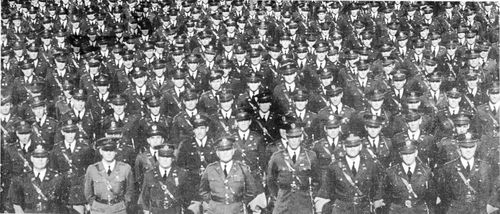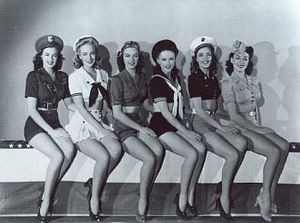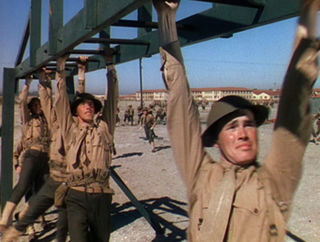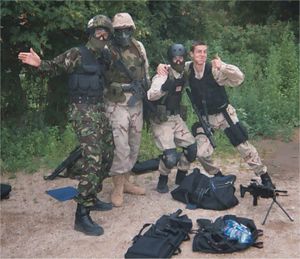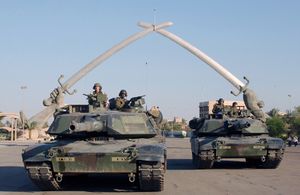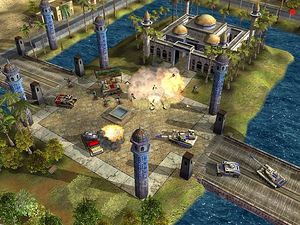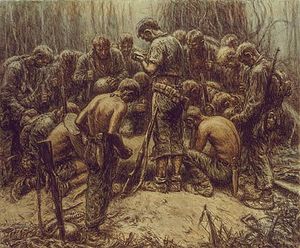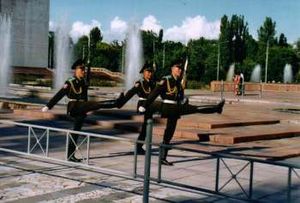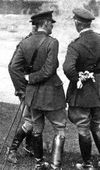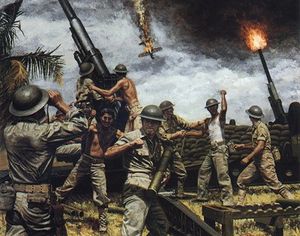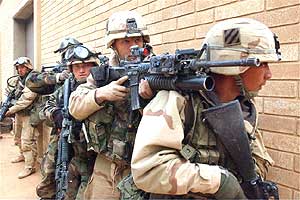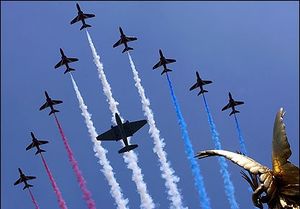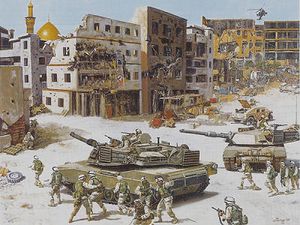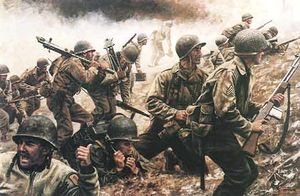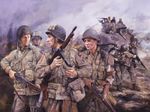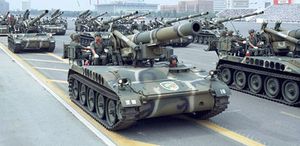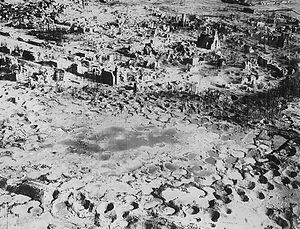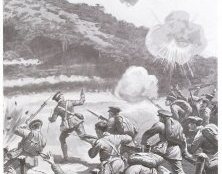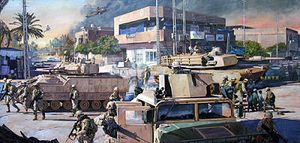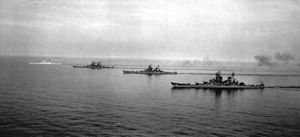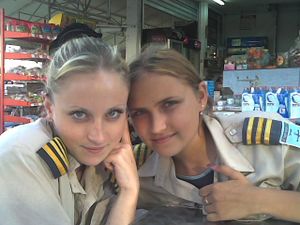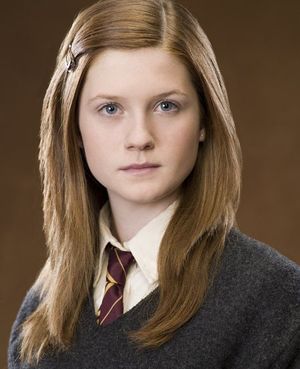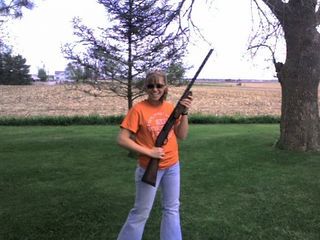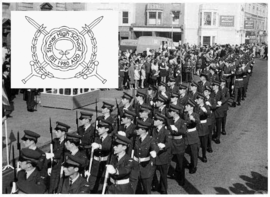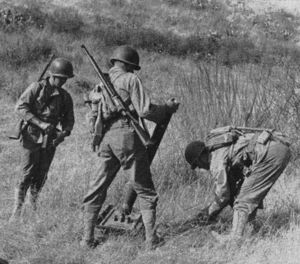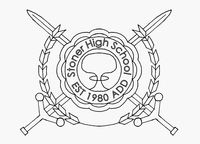Stoner High School/Military
| This article is part of the Stoner High School series. |
|---|
History
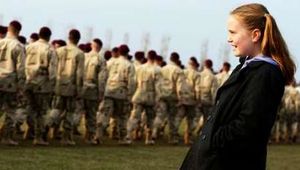
Defense was a high early priority of the new Stoner administration due to the Black Hand Unified School District's repeated attempts at recapturing the school by force. Tiffany I's first official act after being elected Queen was to order 4,000 refurbished M16A1 rifles, 100 Hummers and 50 M1 Abrams tanks from the US government and create the SHS Imperial Army. Under the "armed campus" doctrine, every student is trained in firearms use, unarmed combat, and urban fighting tactics. These skills are honed by a bimonthly paintball tournament. The current Paintball Champion is Air Force Major P.K. Mancini, Class of 2006.
The school now also has its own Navy, Air Force, and Marine Corps, all of which were created after the discovery of a large oil deposit on the baseball field. Persistent rumors of a nuclear program being developed by Mr. Oppenheimer's AP Physics class have yet to be definitively substantiated, and the school is not a signatory to any atomic treaties. The use of an enormous cannon and a mushroom cloud during a border skirmish against the Black Hand Unified School District suggests the Stoner nuclear program is highly developed (see section on the Board of Governors).
The elite SHSIA Queen's Dragoon Guards were chosen to lead the coalition drive on Baghdad during the Iraq War and reportedly inflicted terrifying casualties on the Saddam fedayeen. The King's Dragoon Guards landed with the British forces in the south and helped capture Basra.
Current SHS deployments to South Korea, Japan, and Taiwan are reportedly the subject of much discomfort in Chinese and North Korean military circles. Most fearsome is the SHS Imperial Air Force contingent. While the pilots are technically nothing more than "exchange students" they have been reported some of the world's most dangerous in joint exercises.
The proportion of Stoner High's budget that is spent on defense is comparable to that of Singapore. The main concern is the threat posed by the Black Hand Unified School District, which considers Stoner High a renegade province and has repeatedly threatened to retake the school by force. At present, however, the BHUSD is more afraid of Stoner than Stoner is of BHUSD, the latter's military power having been eviscerated by a very bad series of syphilis cases. This has freed up SHS forces to undertake various other missions around the globe as described above.
Personnel and Equipment
Stoner High's military is regarded as second only to those of the United States and United Kingdom. Joint exercises are conducted frequently with both of these militaries and Stoner often purchases equipment such as F/A-22A Raptors, Rapier anti-aircraft rockets, Patriot missiles and Montana-class battleships from American and British arms manufacturers. SHS military units have served in Afghanistan, the Falklands, Iraq, and downtown Los Angeles with distinction. Much concern has been rising over the SHS military units secret "humanitarian" operations in Argentina duirng the 1980's
Being in the SHS military is considered the equivalent of three honors high school classes for academic purposes (four for officers). It is also recognized as an extremely prestigious "club or service organization" by many universities and as such has an extremely beneficial effect on the student's college application. Veterans organizations for the SHS military exist as well.
Organization
Rank and service structure
| SHS Military Ranks | |||
| OF | SHSN | SHSA | SHSIAF |
|---|---|---|---|
| OF-11 (semi-honorary) | Lord (Lady) Admiral of the Navy | Lord (Lady) Marshal of the Imperial Armies | Lord (Lady) Marshal of the Imperial Air Forces |
| OF-10 | Admiral of the Fleet | Marshal of the Imperial Army | Marshal of the Imperial Air Force |
| OF-9 | Admiral | Field Marshal | Air Marshal |
| OF-8 | Vice Admiral | Vice Marshal (functionally, Corps Commander) | Air Vice Marshal |
| OF-7 | Counter Admiral | Major General (functionally, Division Commander) | Air Counter Marshal |
| OF-6 | Commodore | Major Major Major Major (functionally, Brigade Commander) | Air Commodore |
| OF-5 | Captain (naval) | Major Major Major (functionally, Regimental Commander) | Air Vice Commodore (air force) |
| OF-4 | Commander | Major Major | Commander |
| OF-3 | Vice Commander (naval) | Major | Vice Commander (air force) |
| OF-2 | Senior Lieutenant | Captain (army) | Captain (air force) |
| OF-1 | Lieutenant | Lieutenant | Lieutenant |
| OF-1 | Ensign | Cornet | Pilot Officer |
| W-3 | Chief Warrant Officer | Chief Warrant Officer | Chief Warrant Officer |
| W-2 | Warrant Officer 1 | Warrant Officer 1 | Warrant Officer 1 |
| W-1 | Warrant Officer 2 | Warrant Officer 2 | Warrant Officer 2 |
| E-9 | Master Chief Petty Officer | Sergeant Major | Master Sergeant |
| E-7 | Petty Officer 1st Class | Sergeant 1st Class | Sergeant 1st Class |
| E-6 | Petty Officer 2nd Class | Staff Sergeant | Staff Sergeant |
| E-5 | Petty Officer | Sergeant | Sergeant |
| E-3 | Crunk | High Bongadier | Stoner First Class |
| E-2 | Drunk | Bongadier | Stoner |
The SHS Ministry of War is organized into four major services:
- The Stoner High School Imperial Army (SHSIA)
- The Stoner High School Imperial Navy (SHSN) and its subsidiary the Stoner High School Imperial Marines
- The Stoner High School Imperial Air Force (SHSIAF)
- The Stoner High School Strategic Nuclear Artillery Force, Unified (SHSSNAFU)
The SHS services have rank systems similar to NATO's scales, but with fewer enlisted grades and more officer ranks. This reflects the fact that the SHS military relies more on officers than most world armies. Most freshmen who volunteer for the SHS military enter in the enlisted grades and serve for two years as enlisted soldiers before attending officer candidate school and finishing their careers as seniors in the OF-3 and OF-4 grades of major, or as warrant officers in technical specialties (such as helicopter pilots, snipers, and fire controllers). Only those with superb skill in managing enlisted forces who are not interested in officer positions attain the higher enlisted ranks. Particularly promising candidates are sent directly to the Imperial Institute of the Military Sciences and promoted to the W-1 and OF-1 grades midway through the third quarter of their freshman year. The best field-grade officers are sent to the SHS General Staff Institute between their sophomore and junior years. Graduates of the Institutes form the core of the SHS flag ranks, generally acting as division and corps commanders in their junior year and admirals/marshals in their senior year.
SHS soldiers usually forego 3/4ths of their summer breaks to intensive elective training, including joint maneuvers with the US military, NATO forces and other allied countries' services.
Operational commands
These services are integrated into several operational commands:
- Fockersville Home Command (FOCKHOCOM or, less suggestively, FOXCOM), the school's permanent defense garrison
- FOCKHOCOM is best known for fighting off attempted raids by the Black Hand Unified School District, and has the highest firearms frag score of all the commands. Since the gender split in the SHS military is pretty even, they usually don't bother focking hos (or gigolos, for that matter) despite the name.
- The SHS Imperial Guard (IG), the security force for the Sovereign, the Board of Governors, and other officers of state
- The Imperial Guard is an elite force with integrated artillery, air, naval, and armored capabilities. While its main duty is the protection of key facilities and officials of the school, its units are also deployed as shock troops on the battlefield as they are capable of easily destroying any opponent. It has also acted to safeguard the political integrity of the school (see section concerning the Tyler Incident)
- US West Permanent Expeditionary Force (WESCOM-PEX), also based in Fockersville
- Wescom (wes' side, yo!) is famous for creating a wildly popular new ten-acre moonscape theme park on the site of BHUSD School No. 23 through careful use of battleship guns and B-52s dropping MOAB bombs. As this suggests, it is responsible for offensive operations in the western areas of North America, primarily against the BHUSD. Its primary formation is the Army of Southern California (ASOCAL).
- US East (SEXCOM), based in Intercourse, Pennsylvania
- SEXCOM has never been engaged in combat, but that is definitely NOT why it is so popular among members of the SHS military. Troops deployed to SEXCOM, however, will discover that PT (physical training) is actually pretty fun if done properly.
- East Asia Command Taiwan (ASCOT) in Taipei, Taiwan (Republic of China)
- ASCOT is best known for boarding Chinese shipping vessels filled with lead toys and melting them down to make bullets, as well as for its anti-anime campaign. It also provides security forces for the ROC's secret nuclear deterrent.
- Near East Command (NESTCOM) in Basra, Iraq
- NESTCOM, according to the New York Times, is heavily engaged in baby-killing, fetus-bashing and terrorist torturing. Despite not engaging in the first two activities, they claim to routinely perform all three and provide Photoshopped pictures to "confirm" it, just to piss off Amnesty International. To date, they have received fourteen thousand Brazilian rainforest acres worth of angry letters from the UN. It also has small numbers of peacekeepers in Darfur who act as special forces, using local clothes and weapons.
- South Atlantic Command (SATCOM) in Stanley, Falklands
- SATCOM is the smallest of the commands and is mostly composed of naval and air forces. It frequently interdicts drug shipments out of Colombia, although it is not precisely known what happens to said drug shipments. It's also said to be the reason Hugo Chavez hasn't decided to invade Brazil yet. It operates a satellite base at the Panama Canal, exercising effective secret control over the locks.
- European Command (BEERCOM) in Munich, Germany
- BEERCOM's headquarters is the Munich Hofbrauhaus and, as its short name suggests, it is a really, really FUN place to be. Best known as the real reason the Soviets didn't invade West Germany, it mostly comprises armored divisions and tactical nuclear missile launchers. Vladimir Putin isn't scared of much. He is scared of BEERCOM.
Battles in Stoner History
1st Stoner High
| 1st Battle of Stoner High School | |
|---|---|
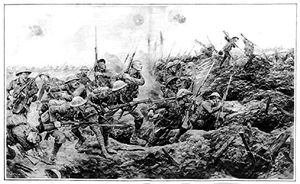 The Freshman Militia charges BHUSD forces across the SUB construction site. | |
| Date: November 23, 1980 - November 27, 1980 | |
| Place: Stoner High School campus | |
| Outcome: Overwhelming SHS victory | |
| Combatants | |
| Provisional Government of Stoner High School | Black Hand Unified School District |
| Commanders | |
| HM Tiffany I, Mr. Ralph Sanchez, Field Marshal Kelly Colter, Wing Commander Scott Fitzroy | Eldred B. Stoner, Jr, Yanni B. Stoner |
| Strength | |
| 18,232 soldiers, 1337 machine guns, 200 tanks, 40 howitzers, 15 fighter-bombers | 65,000 soldiers, 666 tanks, no artillery, 40 bombers |
| Casualties | |
| 420 WIA | 60,000 KIA, 4300 WIA |
The First Battle of Stoner High School occurred when Black Hand Unified School District troops under Eldred B. Stoner, Jr. (bastard child of the school's founder) attempted to recapture the school which had seceded from the school district after the October 5th Revolution. The offensive was timed to begin two weeks before the scheduled pwning date of Principal Dumhaas and had the secondary objective of rescuing him. The battle can be divided into three phases: the initial BHUSD attack, the pitched battle, and the SHS counterattack.
BHUSD attack
BHUSD infantry planned to stage a frontal assault on the school's main gate, which was expected to be heavily defended. SHS forces, however, had detected the presence of the BHUSD several days earlier. Field Marshal Kelly Colter (Class of 1981) deployed her forces to defend the brewery and wine cellars, sending militia units commanded by then-Foreign Minister Ralph Sanchez to plant mines at the school gate on 22 November. The BHUSD lost upwards of 1400 troops in the initial charge into the minefield at 0600 hours on 23 November while failing to clear it. Eldred B. Stoner's deputy (and half-brother) Yanni B. Stoner, was shot by one of Colter's snipers in the initial attack. The first BHUSD wave was almost completely annihilated, with half a dozen stragglers stumbling back to the main BHUSD formation to join the second wave.
Pitched Battle
Harassed by Sanchez's forces, BHUSD troops finally managed to clear the minefield (by sending their worst troops charging under fire across it) by 1300 hours and advance toward the main campus, where they were caught in a withering crossfire by Colter's divisions which had placed artillery on the football fields and emplaced machine guns and snipers in classrooms. Nevertheless they nearly captured the brewery and were only staved off by a ferocious drunken night countercharge by the SHS Alcoholics Anonymous militia, supported by Colter's artillery.
While the main BHUSD force was bogged down at the brewery, a secondary amphibious thrust by the BHUSD personally led by Eldred B. Stoner Jr. landed from the school's Pacific coastline. Taking moderate losses at the beachhead from SHS snipers, they managed to establish a foothold in the lightly defended French and Health classrooms that evening and captured the baseball fields and the volleyball courts at 0900 hours of the 24th. Colter ordered the Sophomore Fusiliers defending those areas to retreat after it was clear they were outnumbered thirty to one. They fell back to the Chemistry wing after inflicting heavy casualties on the BHUSD advance guard. Another BHUSD attack on the Student Union Building construction site was repelled by units of the Freshman Militia and the SHS Metropolitan Police SWAT team.
The BHUSD attempted to send bombers to assist their forces, but Honors Intermediate Aviation students piloting Cessnas led by Wing Commander Scott Fitzroy (Class of 1982) and Colter's antiaircraft guns set up on the school's tennis courts held them off. The bullet-riddled wreckage of the destroyed bombers can be seen today at the SHS War Museum.
Military historians have pointed to the BHUSD's suicidal tactics as a reason for their defeat. The BHUSD disputes this, arguing that the SHS forces cheated by using firearms.
SHS Counterattack
During the battle, Queen Tiffany I personally led the armored divisions comprising tanks of the 1st and 2nd battalions of the Queen's Dragoon Guards, which had been held in reserve hidden in Parking Garage No. 1337, out the back gate of the school.
Moving slowly through rural Fockersville County, they caught the BHUSD tank formations refueling and managed to destroy all 666 tanks with no casualties. They arrived at the front gate where they smashed through the weak BHUSD rear guard around 1200 hours of 25 November and encircled the main BHUSD force on the baseball fields. Pressed by Colter's artillery and infantry from the front, Tiffany I's tanks from behind, and Fitzroy's aircraft from above, the BHUSD forces were split in two and began to crumble.
By this time, Colter's Broadcast Media students had managed to jam all of the BHUSD's walkie-talkies, completely destroying their unit cohesion. Units of the SHS Queen's Regiment of Rifles recaptured all of the lost French classrooms by 1400 hours on November 25th, and the Royal Sophomore Fusiliers recaptured the last Health room at 1530 hours. BHUSD forces at those points either retreated with the main force or were driven back into the sea.
By 1800 hours BHUSD forces were in full retreat, having lost 70% of their strength and all of their heavy weapons. A spirited pursuit by Tiffany's armor, reinforced with D and Double D Batteries of the Queen's Regiment of Heavy Artillery, destroyed nearly all of the remainder and only had to turn back from shelling the Black Hand High School No. 6 campus (where the BHUSD forces had organized) due to ammunition shortages.
Aftermath
The battle was a complete disaster for the BHUSD. Their forces were decimated badly, far out of proportion to the amount of either property or personnel damage they inflicted on the SHS. Total casualties for the SHS forces were only 420 wounded (thanks to body armor and the poor weaponry of BHUSD forces - see picture above). Embedded reporters from the Wall Street Journal, Washington Post, Daily Mail, MSNBC, and the BBC all reported the same: the BHUSD pretty much got served, pwned, sliced, diced, and totally knocked out like a two-year-old in a boxing match with Muhammad Ali. The New York Times, however, insisted that the SHS forces had been defeated, until it was found that Jayson Blair had plagiarized earlier reports on the Battle of the Bulge in writing the article.
Eldred B. Stoner Jr. barely escaped the battle himself, fleeing in his Kia Rio with the Queen's Dragoon Guards in hot pursuit, only escaping by driving into a small residential subdivision in the neighboring city of Fockersville where the SHS tanks could not manuver. He was then ticketed by the Fockersville Police Department for going 80 in a 25 for a brief time before his car fell to pieces. Unable to pay the fine, he was thrown into debtor's prison and then required to work it off with hard labor, disrupting the BHUSD leadership for several months.
Stoner High promptly celebrated with a week-long kegger, although two divisions were always kept sober to look out for a counterattack. The song "Those Were the Days" is generally taken to refer to that event when played on campus.
“You know a good kegger when you can't remember a damn thing because you were so wasted. THAT was a good kegger. Guard duty afterwards was less fun, I still remember how much my head hurt then.”
Fockersville Turnpike Offensive
| The Fockersville Turnpike Offensive | |
|---|---|
 The Stoner Highlanders fearlessly charge BHUSD positions with fixed | |
| Date: March 4th, 1981 - March 5th, 1981 | |
| Place: Stoner High School campus, Unincorporated Fockersville County, BHUSD School No. 5 | |
| Outcome: Overwhelming SHS victory | |
| Combatants | |
| Free Imperial Republic of Stoner High School | Black Hand Unified School District |
| Commanders | |
| HM Tiffany I, Field Marshal Kelly Colter, Admiral Penny Hampton, Marshal of the Imperial Air Force Stephanie Snider | Eldred B. Stoner, Jr, Paul Pohtt |
| Strength | |
| 14,832 soldiers, 1337 machine guns, 666 beer trucks, 400 tanks, 40 self-propelled artillery, 50 fighter aircraft, 2 battleships, 2 cruisers, 3 destroyers, 1 aircraft carrier | 60,000 soldiers, 666 tanks |
| Casualties | |
| -13 1/2 | 55,000 KIA, 2500 WIA |
The Fockersville Turnpike Offensive was a preemptive attack by the SHS Imperial Army and Air Force on Black Hand Unified School District No. 5, which was destroyed in the battle. The most notable aspect of this battle, however, was the discovery of weapons of mass destruction on the campus of BHUSD No. 5 after the conclusion of offensive operations. Aerial reconnaissance had detected a massing of BHUSD troops at School No. 5. SHS forces, fearing a repeat of the attack which had been repelled at the First Battle of Stoner High School, launched an attack on the BHUSD camp using air, land, and sea forces. The battle is still examined at West Point as a study in the employment of combined arms.
Start of the offensive
SHS forces used the Fockersville Turnpike highway as an avenue of attack due to the inability of the BHUSD to strike them while on the move, thanks to SHS air superiority. The BHUSD belatedly attempted to send troops to occupy downtown Fockersville in anticipation of a house-to-house battle where the SHS armored units would not be able to maneuver, but this was prevented by an SHSIAF napalm bombing. For saving the city from BHUSD occupation, Marshal of the Imperial Air Force Stephanie Snider was later presented with the Key to the City of Fockersville by the mayor of the city, William Travis Focker.
The siege commences
The SHS’s self-propelled artillery began shelling BHUSD No. 5 at approximately 0900 hours on 4 March, destroying the walls and gate. Naval bombardment from the Pacific coast destroyed many of the school’s buildings and nearly all of the BHUSD's aircraft and heavy equipment, although it failed to kill most of the BHUSD’s troops. Encircled by the SHS forces on all sides, the BHUSD unwisely decided to entrench in the rubble rather than surrendering immediately and whining pitifully. This was to prove a serious mistake.
House to house fighting
A messy house to house battle ensued beginning around 1300 hours. Unwilling to risk their heavy armor, the SHS forces were compelled to root out the defenders building by building with assault infantry. SHS Imperial Air Force AC-130 gunships and army artillery positioned outside the BHUSD school provided support, but many buildings, especially the heavily defended Remedial Arithmetic classrooms, had to be cleaned out room by room.
These efforts were largely successful and by 1800 hours the BHUSD forces were pushed back into a perimeter around the principal’s office, with a large proportion of their forces having been killed or captured. Despite heavy bombardment and casualties, the Black Hand survivors were able to sustain this position until 0300 hours on 5 March thanks to the incredibly thick walls of stupidity and paperwork which had accumulated in the administration building. SHS forces were forced to don heavy protective equipment as a precaution against potential contamination, slowing their advance.
Surprised by this unexpected delay, the SHS vanguard besieged the building for several hours while SHS forces regrouped. The stalemate irritated the commander on scene, Brigade Commander Mark Wilkinson, who had forgotten to take his ADD meds that day. However, this impatience proved decisive, as Wilkinson ordered SHS forces to break the impasse through any means available. Led by Sergeant Pepper, Major Harvey and Captain Black (shown, left), the crack troops of the SHSIA 69th Airborne Division and the Stoner Highlanders parachuted behind the enemy's lines and took the principal's office by storm. It was in this assault that SHS riflemen became famous for using chainsaws as bayonets. Soon after, C, D and Double D batteries of the 1st Armored Division arrived on the scene and intensified bombardment of the remaining defenders. All BHUSD forces ceased to resist at 0430 hours.
WMD discovered
Principal Paul Pohtt’s desk was captured intact. The principal himself was not found, having been convicted by the SHS artillery divisions under a preponderance of the evidence explosives and summarily executed. Inside the desk, a copy of the famous “Fisher Price” poem was discovered, along with the plans for an underground bunker.
SHS forces managed to locate the site of this bunker, and, effecting a break-in, discovered enormous piles of cans containing a volatile mixture of sarin and stupidity. The SHS nuclear physicists, then already beginning preliminary work on the school’s nuclear weapons project, suspected that the BHUSD had managed to construct a much sought-after Stupidity Reactor. The reactor itself was never found, and likely never existed, given that the stupidity found in the cans seemed not to have been extracted by any mechanical means but simply by conducting lobotomies on BHUSD special ed.
The instigators of the scheme were all captured alive and put on trial for crimes against stupidity. The chief SHS magistrate in the proceedings, Vladimir Kramnitz, suggested that such a “crime” was in fact a benefit to society, but the prosecution was able to prove that in this situation, the extraction of stupidity threatened to propagate said stupidity more widely by harnessing its destructive potential. Hence, although the stupid were themselves victimized, their stupidity was not eradicated but in fact perpetuated.
SHS intervention in the Falklands War
| Falklands War | |
|---|---|
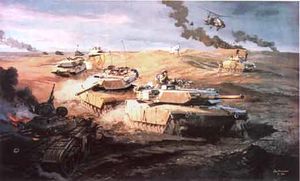 The SHS 1st Armored Division drives toward Buenos Aires. | |
| Date: April 7th, 1982 - June 14, 1982 | |
| Place: Falkland Islands | |
| Outcome: Anglo-SHS victory | |
| Combatants | |
| Free Imperial Republic of Stoner High School | Argentina |
| Commanders | |
| HM Ralph I, Admiral of the Fleet Penny Hampton, Field Marshal Allison Kendall | Leopoldo Galtieri, Mario Menendez, Ernesto Crespo |
| Strength | |
| 24,239 soldiers, 4 battleships, 3 aircraft carriers, 2 battlecruisers, 2 heavy cruisers, 9 destroyers, 7 frigates, 400 aircraft, 400 tanks, numerous other vehicles. | Unknown |
| Casualties | |
| 0 | All |
Political situation
After Argentina invaded and occupied the Falklands, the government of Stoner High School sided with the British, sending a large task force from the SHS Imperial Navy to the South Atlantic.
The following is a brief timeline of events leading up to the SHS intervention:
- March 19th: Argentines occupy South Georgia.
- April 2nd: Argentines occupy the Falklands.
- April 5th: British naval task force sets sail.
- April 15th: SHS Board of Governors votes unanimously to declare war on Argentina.
- April 19th: SHS task force arrives at the Falklands, having sailed at an unknown earlier date in secret.
The SHS had not planned on intervening in the war, presuming that the British, to which they were sympathetic, would easily prevail without SHS help. However, after it became clear that a decisive victory would not be brought about in time for tea and crumpets, British Prime Minister Margaret Thatcher requested SHS assistance in "distracting" the Argentine forces. The original diplomatic communication requested "raids" on the Argentine mainland, but the SHS intervention would quickly escalate into a full-fledged invasion under King Ralph I's "If Something's Worth Doing" doctrine. While the British retook the Falklands, an SHS expeditionary force landed on the Argentine mainland, marched to Buenos Aires and captured Argentine military dictator Leopoldo Galtieri, burning and pillaging everything in their way. Argentina continues to pay tribute of 666 million extra credit points to the SHS every year.
General Belgrano sinking
The sinking of the Argentine cruiser General Belgrano is popularly attributed to the British forces, but this has only been the case because the NEA (National Education Association), the US teachers' union, engaged in a massive bribery scheme that induced all major media outlets to credit the sinking to the British forces. Prime Minister Thatcher privately acknowledged that the ship was sunk not by the British submarine Conqueror but by the SHS battleship Tiffany I, heavy cruiser Ace of Spades and frigates Ninety Proof and Purple Drank.
Invasion of the Argentine mainland
Unanticipated by the Argentines, who were distracted fighting the British in the Falklands, SHS forces were able to enact an April 20th surprise landing at La Plata, almost right outside Buenos Aires. The SHSIA 1st Armored Division, the King's Dragoon Guards, and the 4th and 5th Motor-Rifle Divisions reached the outskirts of Buenos Aires that evening and had established control of the city by 1900 hours. Argentine resistance was both minimal and utterly futile. There were reports of SHS forces playing an Axis of Weasels cover of "Kids in America", Smash Mouth's "All Star", and the Blondie recording of "One Way or Another" on loudspeakers mounted on trucks while they were massacring the hapless Argentine defenders. These rumors have been corroborated by a recently declassified SHS Army document known as the "Falklands Playlist".
Argentine surrender
The Argentine surrender was not precipitated by their defeat at the hands of the British in the Falklands, although this was certainly a factor. Historians agree that it was in fact SHS Imperial Army Field Marshal Allison Kendall who forced Galtieri into an unconditional surrender at gunpoint after the SHS forces had captured the Argentine presidential palace in Buenos Aires.
King Ralph I, Admiral of the Fleet Penny Hampton (the task force commander), and Marshal Kendall received honorary knighthoods from Queen Elizabeth II for their services to the British Empire.
SHS invasion of the Soviet Union
| World War III | |
|---|---|
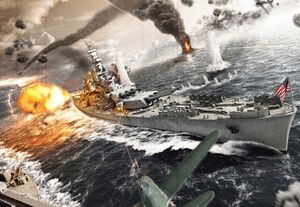 SHS Imperial Navy task force in action off the Siberian coast. | |
| Date: August 30th, 1987 - December 21st, 1987 | |
| Place: Western Europe, Soviet Union | |
| Outcome: NATO-SHS victory | |
| Combatants | |
| Free Imperial Republic of Stoner High School, United States, United Kingdom, Federal Republic of Germany (West Germany), Republic of China (Taiwan), Republic of Korea (South Korea), Japan, Canada, Iceland, other NATO countries, Israel, Eastern European partisans | Union of Soviet Socialist Republics, Warsaw Pact states, Democratic People's Republic of Korea (North Korea), China, France, Libya, Cuba, Syria, Iran |
| Commanders | |
| HM Jessica I, Field Marshal Brad Thompson, Admiral of the Fleet Tracy Roemer, Marshal of the Imperial Air Force Maximilian Jones, Ronald Reagan, General Bernard Rogers, Admiral William J. Crowe, Queen Elizabeth II, Margaret Thatcher, Lord Carrington, Field Marshal Sir Nigel Bagnall, Helmut Kohl, Chiang Ching-Kuo, Chun Doo-Hwan, Noboru Takeshita, Yitzhak Shamin | Zombie Vladimir Lenin, Dmitry Yazov, Yevgeny Shaposhnikov, Willi Stoph, Kim il-Sung, Deng Xiaoping, Jiang Zemin, Li Xiannian, Chi Haotian, Francois Mitterrand, Moammar Qaddafi, Fidel Castro, Hafez Al-Assad, Ruhollah Musawi Khomeini |
| Strength | |
| X | Y |
| Casualties | |
| Z | A |
Background
By late 1986, the deteriorating economic and political condition of the Soviet Union threatened to destroy it from within. Although some Soviet officials believed that the USSR should be allowed to collapse and devolve into its constituent states, most of the Soviet Politburo were convinced that strong action was necessary in order to keep the USSR intact. Soviet forces were sent into the Eastern European states to pacify growing unrest there, while a series of indoctrination campaigns whipped the Red Army into a hyperaggressive, fanatical state.
The Western powers, including Stoner High School, observed these developments with concern. Several attempts were made in the UN by the US and European states (as SHS declined to join the UN) to pass resolutions condemning the Soviet activities, but to no avail as the Soviet Union and France vetoed all such resolutions in the Security Council. French president Francois Mitterrand decried the "English and American attempts, in concert with the Jews and those crazy anarcho-capitalist libertarian frat boys at Stoner High School, to establish a new Anglo-American hegemony over the peoples of the Eurasian continent."
The rise of Zombie Lenin
The conflict finally came to a head when hardline Soviet Politburo members, using secret technology stolen from the Nazis and kept secret for decades, resurrected the embalmed corpse of Vladimir Lenin and made him chairman of the CPSU and president of the Soviet Union, forcibly replacing reformer Gorbachev. Lenin's corpse (now a fully functional clone of Lenin) proceeded to repeal all of Gorbachev, Chernenko and Andropov's moves away from hard-line communism, reverting to a Stalinist model. The KGB expanded from nine directorates to six hundred and sixty-six plus the newly reconstituted OGPU and SMERSH units. The Red Army was expanded back to World War II levels, and a massive wave of purges began in the Stalinist vein. In order to keep the population subdued, vodka production was quadrupled and distributed to the public. [1]
When European academics complained that he was ruining his reputation as Stalin's nicer predecessor in an open letter signed by 1000 of the most prominent leftists in Western Europe, Lenin's corpse responded, "Ha! Useful idiots deceived for make benefit glorious expansion of dictatorship of the proletariat!" Naturally, this confused the aforementioned academics, who remained on the sidelines snorting crack and decrying US imperialism for the duration of the war.
SHS and NATO prepare for war
Queen Jennifer I of Stoner High School introduced a bill in the Board of Governors significantly increasing military spending in support of NATO's higher alert level. A crash program of armaments and munitions production managed not only to equip all of SHS's forces with state-of-the-art weaponry, but also the militaries of nearly all of the school's NATO allies. As a result, in concert with the Reagan-Thatcher military buildup, NATO's forces were at their most modernized level since World War II. All forces were placed on high alert as it became obvious that the Soviet administration under Zombie Lenin was becoming increasingly belligerent toward the West.
Lenin, assessing the enormous size of the Red Army and the political instability of the Eastern European satellite states, decided to launch a long-awaited "liberation" of Western Europe. The Soviet charge into Western Europe on the morning of August 30th was lead by a spearhead of 20 guards tank and infantry divisions and advanced significantly into West Germany before NATO reinforcements arrived.
The invasion begins; SHS, NATO states declare war on the USSR
The SHS Board of Governors hastily authorized a declaration of war on the Soviet Union on the afternoon of the 30th, as the Soviet forces had approached to within 50 miles of Munich and threatened to capture its beerhouses (as well as the SHS military command BEERCOM).
In what can be only termed a supreme masterstroke of strategic pwnage, SHS and NATO forces quickly sank all of the USSR's nuclear missile submarines. Those which escaped destruction through concealment attempted to launch on their targets but were foiled at the last minute as SHS 1337 haxx0rs successfully broke the Soviet Union's firewalls and were able to gain root access to the Soviet computer system, canceling the launches and revealing the location of the subs, which were quickly sunk. Reportedly, they significantly underestimated this task as hacking computers made of vacuum tubes is extremely difficult.
Simultaneously, dozens of strike teams from the SAS, CIA and SHS Imperial Guard were inserted inside the Soviet Union to capture and sabotage the Soviet missile silos so they could not be launched manually. Details of how the missiles were physically destroyed are still highly classified. Nevertheless, it is clear the entire Soviet nuclear capability was neutralized by 2100 hours on August 30th, before the war even began in earnest.
USSR captures France and North Africa
Their strategic rocket forces essentially annihilated, the Soviet forces redoubled their efforts on the ground. A Spetsnaz team of 12 men parachuted into Paris on September 5th. At once, at the orders of French president Francois Mitterrand, a Soviet sympathizer, all French forces in the area proceeded to locate and surrender to this special forces team. The French government sued for peace and joined the USSR.
Simultaneously, Soviet divisions entered Egypt through the Sinai Peninsula and, with the help of Libyan forces, quickly captured most of North Africa by September 12th. Israel (bypassed in the initial Soviet thrust) came under attack on the 14th and despite having to cede a large amount of ground to the Soviets ultimately managed to inflict pyrrhic losses, enough to force them to simply encircle Israel and bombard it (largely unsuccessfully) from Syria and Palestine.
With France, North Africa, the Middle East and significant parts of Europe under their control, the Soviets had West Germany and Italy surrounded on three fronts, and the situation was looking, well, pretty shitty.
East Asian countries declare war on the USSR
Their defenses in the East drawn down in order to provide manpower for the western front, the Soviets were vulnerable to attacks in their rear, a risk Zombie Lenin had opted to take with assurances from China and North Korea that they would defend his rear flank.
On September 9th, Taiwan (ROC) and Japan declared war on the USSR, China (PRC) and North Korea in support of NATO; South Korea was reluctant to do so until SHS participation in a joint offensive was assured, and their declaration of war was issued in the early hours of September 10th. These declarations were met by amphibious assaults by China on Taiwan and Japan on September 14th, which were repulsed with heavy casualties by the SHS 5th Fleet under the command of Admiral of the Fleet Hannah Dakota (Class of 1987). Nearly the entire PRC navy was sunk in the battle, and as SHS battleships began to bombard the Chinese coast on the 16th, Japanese and ROC forces executed series of counter-landings near Shanghai under the cover of American and Stoner air support. They captured Shanghai's port facilities the same day and began to land heavy divisions at a frightening pace, defeating attempts by the PRC forces to push them back into the sea.
North Korea seized the initiative and quickly launched its massive army across the 38th parallel at the commencement of hostilities on the 10th, forcing American and South Korean forces into a defensive perimeter around Seoul and putting the city under a brief siege. Attempts by the garrison of Seoul to break out of the encirclement were unsuccessful, although the North Koreans took heavy casualties during the attacks.
To rescue the beleaguered army at Seoul, the SHS 4th Army under Field Marshal Tom Brady (Class of 1987) landed at Pusan alongside a large contingent of American reinforcements on the morning of the 12th and drove north, smashing the North Korean columns in a pincer and a lengthy tank battle and lifting the siege of the South Korean capital. Meeting the South Korean army and the American garrison at Seoul, this force crossed the 38th parallel northbound on the 15th of September. The bulk of the North Korean forces were destroyed in the field on the 19th and 20th attempting a last-ditch defense of Pyongyang, and the lead vehicles of Brady's division entered the North Korean capital on the morning of the 21st, greeted with only sporadic resistance.
“It was the absolute worst time of my life... all the North Korean supply dumps we captured didn't have a single pint of booze in them, and we had to fight the entire fucking campaign sober except for a couple cases of sake flown out of Okinawa. It was quite possibly the longest time I've been sober since I was 12.”
The PRC managed to hold the North Korean border, and a two-month stalemate blunted the NATO-SHS offensive in the north. A brilliant logistics operation headed by Air Marshal Travis Healey (Class of 1988) continuously flew cases of alcoholic beverages from port cities in Japan to the SHS front lines. It was subsequently dubbed the Panmunjeom Airlift because whoever did the dubbing was too drunk to pick a city at the right latitude.
However, things were moving quickly elsewhere. ROC and Japanese forces secured the Shanghai-Nanking area by September 20th and a second landing on the south coast commanded by Field Marshal Alice Thompson (Class of 1988) captured Canton on the 22nd, linking up with an Anglo-American task force that had occupied Hong Kong on the 21st.
The PRC surrendered on September 23rd, as the SHS armored spearhead closed in on Peking. SHS and allied forces in the east restored the ROC government and proceeded north to invade Siberia in early October, waiting only to receive shipments of winter supplies.
SHS reinforcements arrive in the west; the counteroffensive begins
With BEERCOM under pressure from Soviet forces, the SHS military dispatched most of its forces to Europe to defeat the Soviets. Upon the arrival of SHS reinforcements, the NATO armies successfully counterattacked, recapturing France and all the lost parts of West Germany by October 15th and cutting off supplies to the Soviets in North Africa.
Strategic bombing of the Soviets' production facilities began on October 12th and continued until the end of the war, executed mostly by the USAF and the SHSIAF.
SHS forces invaded East Germany next, capturing large stockpiles of Russian vodka which was sadly deemed unfit for consumption and sent to the West for refitting and refermenting. The DDR ceased to exist on October 27th, and the Berlin Wall was torn down by the West German military to great fanfare.
NATO-SHS forces briefly debated whether to actually invade the other Warsaw Pact states. A special meeting of the NATO heads of state and ministers of defense was held on November 2nd to discuss this. In the end, spurred by HM Jessica I, NATO voted unanimously to continue moving east.
“It is my every intention to finish the war before spring break. We've better things to do then than pump the Reds full of lead and depleted uranium... It is time, therefore, to end the disgraceful charade of detente and to drive forward without delay... our enemies have little choice to surrender or be annihilated, swept before us like dirt before the broom.”
Famous SHS military figures
Field Marshal Kelly Colter
An Obergruppenfuhrette in the Confederation of Concerned Students, senior Kelly Colter (Class of 1981) was born in a fishing village in rural Wales. She gained renown sometime in the 1970s for an incident during a trip to Manchester during which six drunken Irishmen attempted to steal her handbag and were repulsed with heavy casualties. Later moving to the USA, she transferred into Stoner High School as a junior and thus spent only two years there. They were, however, most eventful.
Prominent in the run-up to the revolution as the Confederation sabotage varsity team captain, she racked up innumerable thumbtackings, spitballings, transcript shreddings and land minings as she made life hell on earth for those teachers who had incurred the wrath of the student body with their authoritarian ways. No teacher dared to hand out detention to her for fear of the torrent of retribution that would fall upon them.
During the September Riots leading up to the Revolution, Colter was active in recruiting students into the Confederation, marshaling what was once a disorganized and very stoned mob into a cohesive and tight-knit but still very stoned mob.
After being appointed one of Tiffany I's senior military commanders, Marshal Colter was engaged in building the SHS armed forces in the run-up to the First Battle of Stoner High School, during which units under her command performed spectacularly. At graduation her only expressed regret about her years at SHS was that she didn't "get the chance to bust a cap in Dumhaas."
She returned to her homeland after graduating and is now Commandant of the Royal Marines.
Sergeant Candace York
See this section for historical background.
Candace York (Class of 1984) was born in a log cabin in back-country Georgia, the oldest of five children. Her parents were high-school dropouts, but encouraged their daughter to attend school; York had to walk five miles to Bull Connor Elementary School in the snow (both ways uphill) every day. [2] Her father taught her the use of firearms at an early age and gave her a Remington 12-gauge for her 5th birthday. With the family short on cash for macaroni and cheese, Candace hunted quail and possums after school to feed her three younger brothers and little sister. She graduated from Billy Joe-Bob Junior High in in 1979, but decided not to attend high school in Georgia. Winning the prestigious Jagger scholarship for underprivileged students, York entered Stoner High as a freshman in 1980, the year of the Revolution. On the first day of school, she was identified by Principal Dumhaas's brown-nosing informants as a potential troublemaker. One of Dumhaas's cronies confronted her with a lead pipe in front of a crowd of other freshmen, seeking to give the entire incoming class a stern warning. Instead of giving a lesson, he got a couple new assholes (or face-holes) the size of a .357 Magnum round from York's Colt Python, and the freshman class received what was essentially the opposite of a warning.
York went into hiding during the first week of school until the September Riots broke out, during which she emerged as the leader of a large angry mob of freshmen. Although not formally part of the Confederation of Concerned Students, she was a driving force in the general uprising.
Appointed Command Sergeant Major of the Imperial Army in the new SHS armed forces, she was chief of the Special Operations commando unit during the First Battle of Stoner High School, during which the Black Hand Unified School District attempted to retake the Stoner campus. The unit distinguished itself near the end of the battle when, during the general BHUSD retreat, they managed to surround BHUSD colonel Subuaf Lavro [3], who had been one of Dumhaas's top brown-nosers at SHS and had then become one of the ex-principal's brigade leaders. While Lavro's men fought a losing battle with S.O. forces, York and a handpicked squad of S.O. men infiltrated his headquarters and caught him literally with his pants down. York's second-in-command, Sergeant Eddie Pepper, fired at Lavro but hit the camel he had been shagging instead. In the confusion, Lavro managed to pull up his pants, grab his AK-47 and, hiding behind the camel's body, proceed to pin down Pepper and four others behind a mineral water cabinet. Sergeant York and another of her men, Corporal Ron Peas, who had been covering Pepper outside Lavro's tent, burst into the tent to assist just as a platoon of forty BHUSD troops from Dumhaas's elite Syncophantic Guard who had been sent to rescue the colonel arrived. York struck Lavro in the back of the head with the butt of her Winchester M1897, knocking him unconscious. Then, as the Guard bore down upon them, she disappeared. She was nowhere and everywhere at once, and at the end of the thirty-second rampage, fifty Syncophants lay dead, mostly from lethal buckshot head wounds but a couple from really hard kicks in the crotch.
For somehow managing to kill more of the attackers than had actually been in the opposing force, and for bringing back Colonel Lavro back to SHS lines as a prisoner, Sergeant York was awarded the Tiffany Cross. The Special Operations forces received a Royal Unit Citation. A computer glitch also promoted her from Sergeant Major to just plain Major. Apparently deciding to overlook the mistake, the SHS army chief of staff Field Marshal Ernie McMahon placed her in command of the Freshman Militia after the battle.
Although only a sophomore during the SHS intervention in the Falklands, Major York was placed in command of the 69th Airborne Division, which was parachuted into Argentina ahead of the SHS amphibious landing to destroy key Argentinian coastal emplacements. She again distinguished herself by inexplicably destroying more Argentinean guns than the enemy had, as well as capturing 3,000 prisoners, each of which she ransomed back for 100,000 extra credit points (or about $13514 US) each. Not surprisingly, her cumulative GPA at graduation was a 4.0.
Major York eventually rose to the rank of Vice Field Marshal, then became Minister of War in her senior year under Queen Phoebe I. She attended Stanford, majoring in Sexual Chemistry (or S-Chem as students called it), then went to University of Washington Medical School. She is now chairwoman, CEO and majority shareholder of York Armaments Corporation, which manufactures tanks, armored personnel carriers, and ammunition for the SHS military.
Notes
- ↑ The Government of SHS initially applauded this move until it was discovered that said vodka was intended for domestic consumption within the USSR only.
- ↑ SHS transit authority police often reminded their fellow students of this fact in later years when there were complaints about the SHS commuter trains being late.
- ↑ Rumored to be related to segregationist politician Orval Faubus; this has never been proven.
|
1. Home |
8. Geography |
